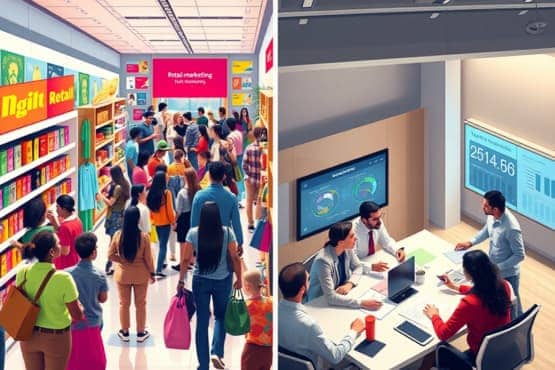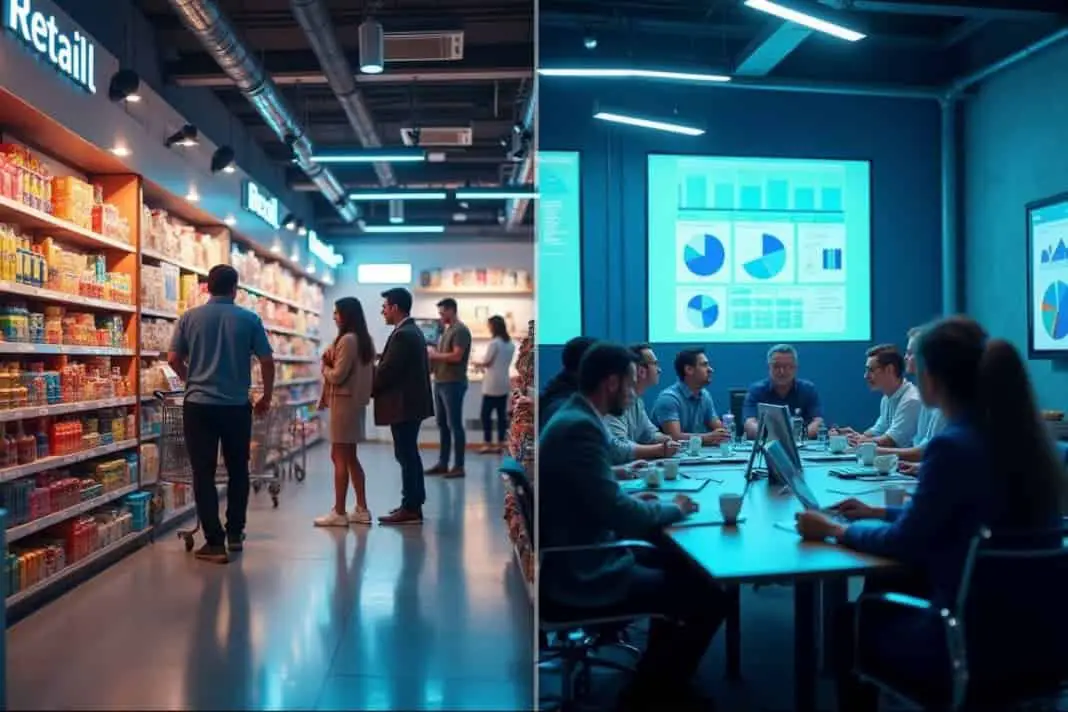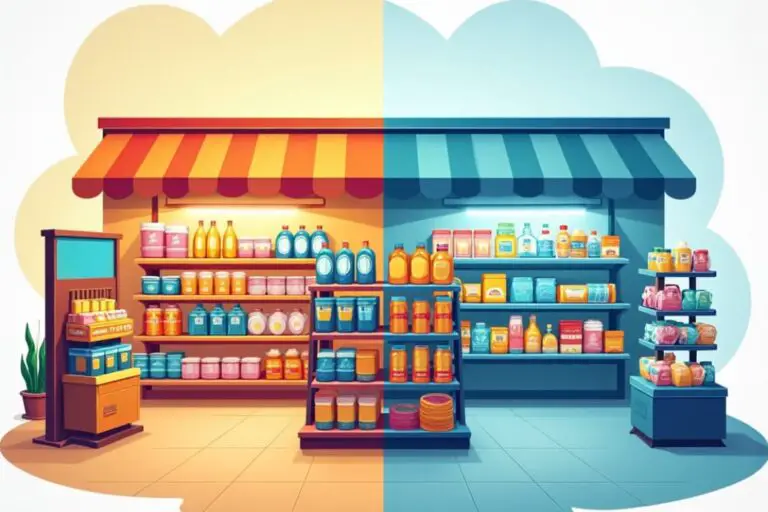Understanding how retail and trade marketing work together is crucial for business success today. When combined, these strategies can lead to amazing results. Let’s explore how they differ, how they work together, and how new technology is changing both approaches.
A recent McKinsey study found that companies that successfully combine their retail and trade marketing efforts see their revenue grow by 10% on average. They also save up to 20% in costs. Let’s dive into how you can achieve similar results.
Key Takeaways:
- Retail marketing targets shoppers, while trade marketing focuses on business partners.
- Combining both strategies leads to better results
- Digital tools and AI are changing how we market
- Successful brands focus on teamwork and reaching customers everywhere
- Avoiding common mistakes is key to effective marketing
What Are Retail and Trade Marketing?
Retail Marketing: Connecting with Shoppers
Retail marketing is all about engaging individual shoppers. It aims to create memorable brand experiences and encourage purchases through effective shopper marketing and trade marketing tactics.
Key elements include:
- Targeted ads can enhance the effectiveness of marketing communication and influence the purchase decision.
- In-store promotions
- Customer loyalty programs
- Personalized online experiences
Real-World Example: Nike’s retail marketing strategy shows this approach in action. Their Nike App uses location data to offer personalized in-store experiences. This connects online and in-store shopping. As a result, app users are 50% more likely to buy again.
Trade Marketing: Building Business Partnerships
Trade marketing targets the businesses that help get products to shoppers – like wholesalers, distributors, and retailers. This business-to-business (B2B) approach involves:
- Negotiating with retail partners
- Offering trade promotions and incentives
- Working together on marketing plans
- Improving the supply chain
Case Study: Procter & Gamble worked with Walmart on trade marketing to create their “Store of the Future” concept. This teamwork led to better product placement and increased sales for both companies, ultimately enhancing their sales and marketing efforts. Some product categories saw up to a 20% increase in revenue.
How Retail and Trade Marketing Differ and Work Together
Understanding the differences and connections between retail and trade marketing is key to developing effective strategies:

| Aspect | Retail Marketing | Trade Marketing |
|---|---|---|
| Who it targets | Individual shoppers | Business partners |
| Main goals | Drive purchases, build brand loyalty | Secure shelf space, strengthen business relationships |
| How it communicates | Emotional, focused on benefits | Data-driven focused on results |
| Promotion tactics | Social media campaigns, coupons, in-store events | Volume discounts, shared advertising, optimizing product placement |
| Success measures | Sales volume, customer satisfaction, brand awareness | Distribution coverage, sell-through rates, partner satisfaction |
While these strategies are different, when they work together, they can create powerful results:
- Sharing Data: Retailers provide valuable insights about shoppers, helping trade marketers improve their shopper marketing and trade marketing strategies.
- Consistent Messaging: Working together ensures a unified brand message across all channels.
- Joint Promotions: Collaborations between brands and retailers create win-win situations.
- Better Product Placement: Trade marketing secures prime shelf space, boosting the impact of retail marketing.
- Ongoing Improvement: Shopper feedback helps improve products, which benefits trade relationships.
Digital Tools Bridging the Gap
New digital technologies are changing how retail and trade marketing strategies work together.

Here are the key tools driving this integration:
- Customer Data Platforms (CDPs): Tools like Segment or Tealium combine customer data from various sources. This enables personalized shopping experiences while informing trade strategy.
- Trade Promotion Optimization (TPO) Software: Platforms such as Accenture’s Cloud TPM help brands analyze how well trade promotions work across different retail channels.
- Artificial Intelligence (AI) and Machine Learning: AI-driven tools like IBM’s Watson Commerce use predictive analytics to improve pricing and promotions across retail and trade channels.
- Omnichannel Marketing Platforms: Solutions like Salesforce Marketing Cloud create smooth marketing experiences across online and offline touchpoints.
- Blockchain for Supply Chain: Companies like Walmart use blockchain to improve transparency and traceability. This benefits both trade partners and end consumers.
According to Gartner, organizations using these digital tools see a 30% improvement in marketing ROI compared to traditional methods.
Best Practices for Effective Teamwork
To get the most benefits from combining retail and trade marketing, consider these strategies that leverage data-driven insights.

- Set Shared Goals: Align objectives to support overall business targets in marketing and trade marketing efforts.
- Create mixed teams: Form teams that leverage diverse skills to enhance marketing and trade marketing outcomes. Form teams that include both retail and trade marketing experts.
- Use Data Analysis: Use consumer and trade partner data insights to guide strategy.
- Think Omnichannel: Develop campaigns that work across all sales channels to create a cohesive marketing communication strategy.
- Keep Learning: Stay updated on market trends and new technologies.
Case Study: L’Oréal’s “Connected Beauty Incubator” combines retail marketing, trade partnerships, and product development. This led to innovations like the Lancôme Le Teint Particulier Custom Made Foundation.
This uses in-store technology to create personalized products. It has improved the shopping experience and strengthened relationships with retail partners. As a result, L’Oréal saw a 30% increase in keeping high-value customers.
Common Mistakes to Avoid
While combining retail and trade marketing offers many benefits, it’s important to watch out for potential challenges:

- Working in Silos: Failing to share information between retail and trade teams can lead to missed opportunities.
- Solution: Hold regular cross-team meetings and use shared digital platforms.
- Inconsistent messaging: Disconnected communication can confuse shoppers and partners.
- Solution: Develop a central content strategy that aligns all marketing efforts.
- Ignoring Digital Integration: Failing to connect online and offline strategies can result in disjointed customer experiences.
- Solution: Invest in omnichannel marketing platforms to ensure consistency across all touchpoints and support integrated marketing and trade marketing efforts.
- Not Listening to Partners: Failing to consider input from trade partners can lead to ineffective promotions.
- Solution: Set up regular feedback loops with distributors and retailers to inform strategy.
- Overusing Discounts: Focusing too much on price promotions can hurt brand value and partner relationships.
- Solution: Develop value-added promotions that benefit everyone, such as exclusive product launches or educational content.
Future Trends in Retail and Trade Marketing

Several emerging trends are set to transform the marketing landscape:
- AI-powered personalization: can significantly influence purchase decisions by tailoring offers to individual preferences. Advanced AI will enable highly personalized experiences across both retail and trade channels.
- Voice Commerce: As voice-activated shopping grows, brands must optimize for voice search in B2C and B2B contexts.
- Augmented Reality (AR) Experiences: AR will connect online and offline shopping, offering immersive experiences for shoppers and valuable tools for trade partners.
- Sustainability Focus: Both shoppers and trade partners will prioritize eco-friendly practices, influencing product development and marketing strategies.
- 5G Technology: Faster, more reliable internet will enable real-time data sharing and enhanced digital experiences across the supply chain.
A PwC study found that 86% of buyers are willing to pay more for a great customer experience. Brands using these trends to create seamless, personalized journeys across retail and trade touchpoints will likely succeed.
Conclusion: Steps to Take for Integration
As retail and trade marketing become more connected, businesses must adapt to stay competitive. Here are key steps to take:
- Review Your Current Strategy: Check how well your retail and trade marketing efforts work together.
- Invest in Technology: Choose digital tools that simplify sharing data and planning.
- Train Your Teams: Make sure all marketing staff understand retail and trade perspectives.
- Create Integrated Campaigns: Develop marketing initiatives using consumer insights and trade partner strengths.
- Measure and Improve: Regularly review performance metrics and adjust strategies as needed.
By following these practices, you can create a powerful, integrated marketing approach that connects with both shoppers and business partners.
Ready to transform your marketing strategy? Download our free “Retail and Trade Marketing Integration Guide” to assess your current efforts and identify key areas for improvement. This comprehensive resource will help you navigate the complexities of modern marketing and set your business up for success.
Remember, in today’s connected marketplace, success comes from breaking down barriers and creating seamless experiences across all channels. The future of marketing is integrated – are you ready to lead the way?
Frequently Asked Questions
How can small businesses integrate retail and trade marketing?
Small businesses can start by aligning their messaging across all channels, using affordable digital tools to track consumer and trade partner data, and creating promotions that benefit shoppers and retail partners.
What are the key differences between retail and trade marketing?
Retail marketing targets individual shoppers and drives purchases, while trade marketing targets business partners and aims to secure better product placement and distribution.
What role does AI play in retail and trade marketing?
AI helps personalize shopping experiences, optimize pricing and promotions, predict trends, and improve supply chain efficiency, benefiting retail and trade marketing efforts.
How can I measure the success of integrated retail and trade marketing efforts?
Look at combined metrics like overall sales growth, market share increases, improved partner satisfaction scores, and enhanced customer lifetime value to gauge the success of your integrated efforts.
What are some cost-effective ways to start integrating retail and trade marketing?
Begin by sharing data and insights between teams, creating joint promotions with key retail partners, and using free or low-cost digital tools to track and analyze performance across both areas.




